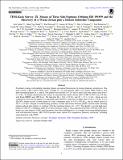TESS-Keck Survey. IX. Masses of Three Sub-Neptunes Orbiting HD 191939 and the Discovery of a Warm Jovian plus a Distant Substellar Companion
Author(s)
Seager, Sara
DownloadPublished version (1.756Mb)
Publisher with Creative Commons License
Publisher with Creative Commons License
Creative Commons Attribution
Terms of use
Metadata
Show full item recordAbstract
Exoplanet systems with multiple transiting planets are natural laboratories for testing planetary astrophysics. One such system is HD 191939 (TOI 1339), a bright (V = 9) and Sun-like (G9V) star, which TESS found to host three transiting planets (b, c, and d). The planets have periods of 9, 29, and 38 days each with similar sizes from 3 to 3.4 R⊕. To further characterize the system, we measured the radial velocity (RV) of HD 191939 over 415 days with Keck/HIRES and APF/Levy. We find that Mb = 10.4 ± 0.9 M⊕ and Mc = 7.2 ± 1.4 M⊕, which are low compared to most known planets of comparable radii. The RVs yield only an upper limit on Md (<5.8 M⊕ at 2σ). The RVs further reveal a fourth planet (e) with a minimum mass of 0.34 ± 0.01 MJup and an orbital period of 101.4 ± 0.4 days. Despite its nontransiting geometry, secular interactions between planet e and the inner transiting planets indicate that planet e is coplanar with the transiting planets (Δi < 10°). We identify a second high-mass planet (f) with 95% confidence intervals on mass between 2 and 11 MJup and period between 1700 and 7200 days, based on a joint analysis of RVs and astrometry from Gaia and Hipparcos. As a bright star hosting multiple planets with well-measured masses, HD 191939 presents many options for comparative planetary astronomy, including characterization with JWST.
Date issued
2022Department
Massachusetts Institute of Technology. Department of Earth, Atmospheric, and Planetary SciencesJournal
Astronomical Journal
Publisher
American Astronomical Society
Citation
Seager, Sara. 2022. "TESS-Keck Survey. IX. Masses of Three Sub-Neptunes Orbiting HD 191939 and the Discovery of a Warm Jovian plus a Distant Substellar Companion." Astronomical Journal, 163 (2).
Version: Final published version